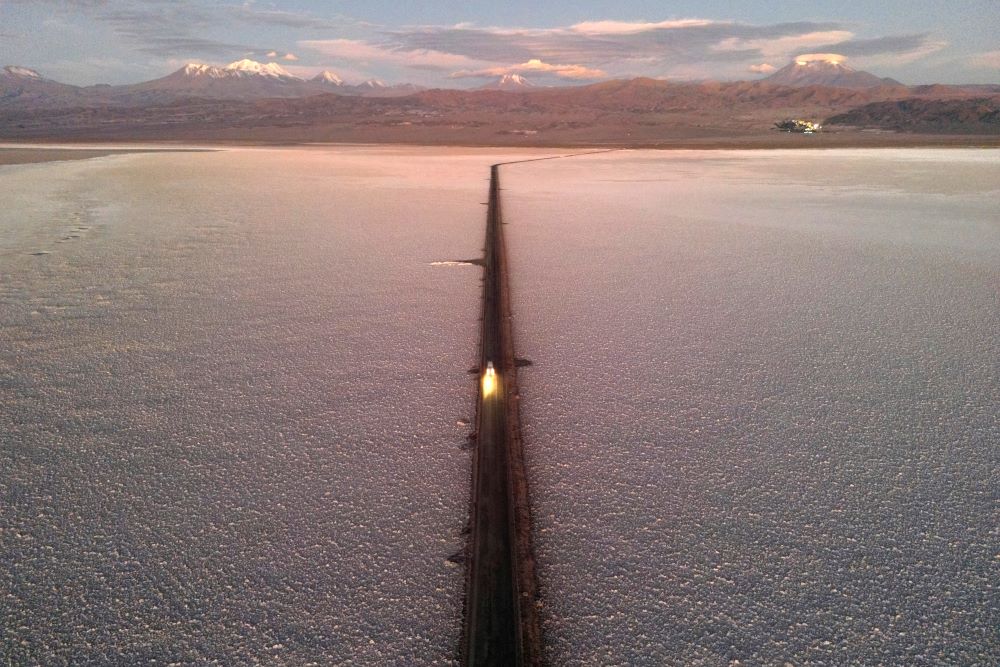
A car drives down a road through the Salar de Atacama salt flat near the Albemarle lithium mine in Chile on April 17, 2023. Parched waterways surrounding towns like this are connected with white salt flats below, subterranean lagoons with waters jampacked with "white gold": lithium. (AP/Rodrigo Abd)
Irene Leonor Flores de Callata, 68, treks along a bone-dry riverbed, guiding a herd of llamas and sheep through stretching desert.
Flores de Callata's Native Kolla people have spent centuries climbing deep into the mountains of northern Argentina in search of a simple substance: fresh drinking water.
Here, in one of the most arid environments in the world, it's a life force that underpins everything.
In rainy months, the sacred lands surrounding their small adobe town of Tusaquillas well with water. In the dry months, families hike miles under the beating sun, hopeful their livestock can sip from a small plastic container, fed by a hose running high into the distant mountains.
Today is a lucky day. Their blue container is brimming with fresh water.
But communities like hers increasingly worry that their luck may run out. That's because the parched waterways surrounding their town are intrinsically connected with spanning white salt flats below, subterranean lagoons with waters jampacked with a material that's come to be known as "white gold" — lithium.
In the "lithium triangle" — a region spanning Argentina, Chile and Bolivia — Native communities sit upon a treasure trove of the stuff: an estimated trillion dollars in lithium.
The metal is key in the global fight against climate change, used in electric car batteries, crucial to solar and wind energy and more. But to extract it, mines suck water out of the flats, tethered to the lives of thousands of communities like Flores de Callata's.
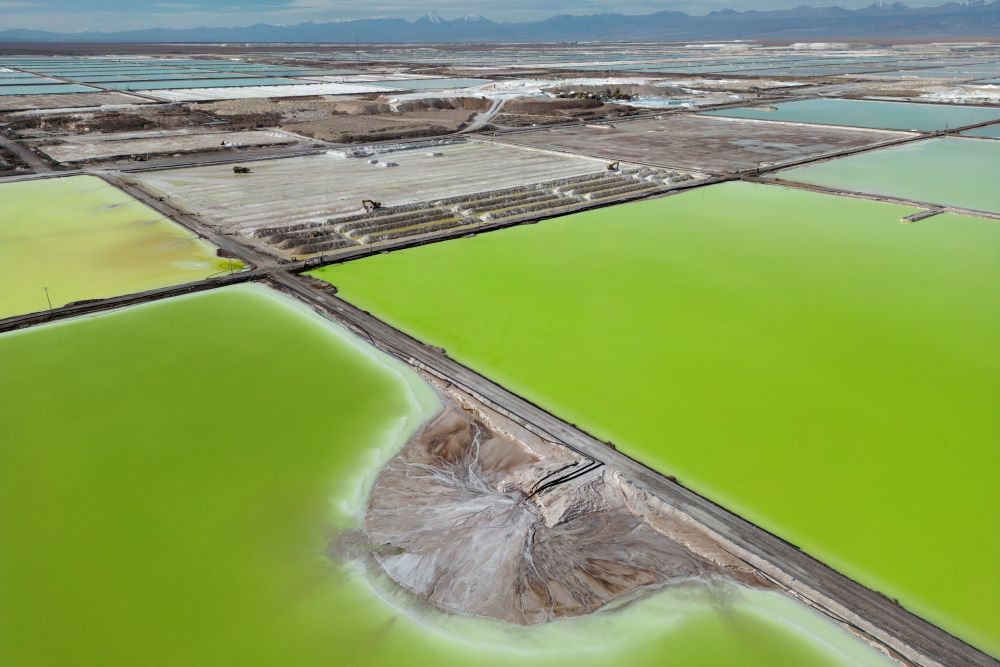
Brine evaporates in pools at the lithium extraction plant facilities of the SQM Lithium company near Peine, Chile, on April 18, 2023. In the “lithium triangle” — a region spanning Argentina, Chile and Bolivia — Native communities sit upon a treasure trove of the stuff: an estimated trillion dollars in lithium. (AP/Rodrigo Abd)
As the world's most powerful increasingly look toward the triangle, the largest reserve of lithium on Earth, as a crucial puzzle piece to save the environment, others worry the search for the mineral will mean sacrificing that very life force that has sustained the region's Native people for centuries.
"We will lose everything," said Flores de Callata. "What will we do if we don't have water? If the mines come, we'll lose our culture, we won't be left with anything."
___
At the same time Flores de Callata's town and thousands of others across the lithium triangle have lived quietly off the sparse food and water their lands offer, the price for lithium skyrocketed in 2022.
Between 2021 and 2023, the price for 1 ton of lithium in U.S. markets nearly tripled, reaching a high of $46,000 a ton last year, according to a U.S. Geological Survey report. In China, the main customer of the region's lithium, a ton of the metal went for a whopping $76,000 at its peak last year.
'What will we do if we don't have water? If the mines come, we'll lose our culture, we won't be left with anything.'
—Irene Leonor Flores de Callata
Leaders, mining executives and companies from across the world look to the region's barren deserts both as a source of wealth and an engine to power the transition to green energy.
The "white gold" they seek is contained in the hundreds of salt flats, or salares, speckling the region.
From afar, they look like fields of Arctic snow, but below are deep wells of salted groundwater packed with minerals. Unlike other forms of mining, lithium here is extracted not from rock, but rather from the brine water pumped from the salt flats.
The salt flats also act as an essential part of a highly biodiverse ecosystem, say scientists like Ingrid Garcés, a hydrologist from Chile's University of Antofagasta.
While the water inside the lagoons is not drinkable, they are tethered to surrounding fresh water sources, sparse rains and nearby mountain streams, essential for the survival of thousands of Indigenous communities.
Scientists interviewed by the AP said that industrial-scale water pumping both contaminates fresh water with brine they pump and effectively dries up the surrounding environment. They say it's produced cascading ripple effects for life in the region at a time it's already been hit by climate change-induced drought.
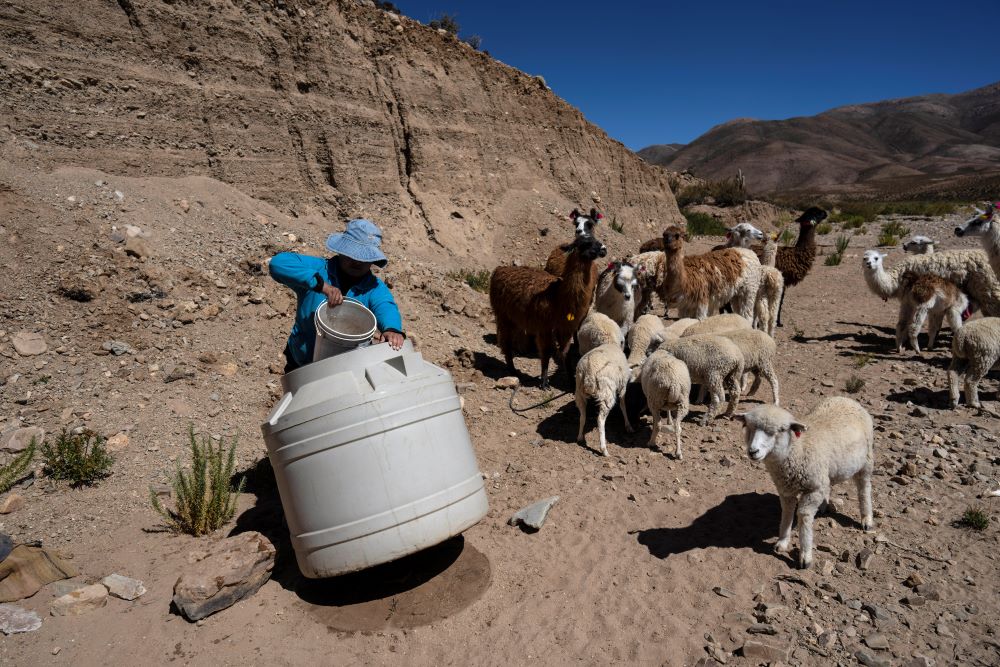
Vilma de Callata, 45, draws water for her animals in Tusaquillas, Jujuy Province, Argentina, on April 23, 2023. Her native Kolla people have spent centuries climbing deep into the mountains of northern Argentina in search of fresh drinking water. (AP/Rodrigo Abd)
"We're talking about a living ecosystem, because what you're extracting from this salt flat is water. And water is life," Garcés said. "Think of it as an interconnected ecosystem."
Because of their environmental significance, the salt flats and their surrounding waters have gained a sacred place for Indigenous cultures, an essential part of Native celebrations the entire month of August.
Flores de Callata's town is one of 38 pressed up against two such salt flats — the Guayatayoc lagoon and Salinas Grandes — which bring income to towns like hers through tourism and small-scale salt harvesting.
At the beginning of any day of work, Flores de Callata's family makes an offering to Pachamama, an Andean deity representing the Earth. Inside their stone corral of llamas and sheep, they dig a hole in the ground, burying coca leaves, meant to represent life, and a clear liquor, representing water.
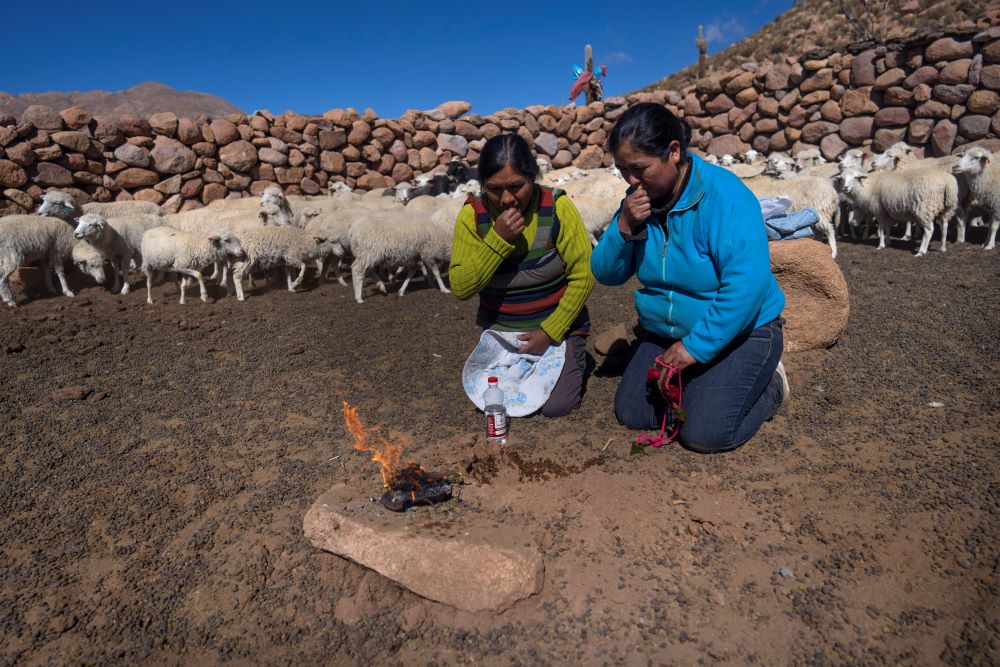
Vilma de Callata, left, and her sister, Katty de Callata, make an offering to the Earth while they look after their animals in Tusaquillas, Jujuy Province, Argentina, on April 23, 2023. (AP/Rodrigo Abd)
Just as the basin provided for the Kolla people, fundamental to their culture is giving back to the land. For decades, their collective of communities have fought off large-scale mining and waged long legal battles to halt projects.
But year by year, it's grown more difficult to fend off those mining companies.
More than 30 companies are officially seeking permission to mine the water in the two salt flats. Signs put up by the community line the edges of the flats reading, "Respect our territory. Get out, lithium company."
Things came to a head last summer when the local government, eager for the profits by the mines, changed its constitution, making it easier to waive certain Indigenous land rights and limiting the ability to protest against the expansion of mining.
Alicia Chalabe, the environmental lawyer representing the communities, and others argue the move violates international law.
Thousands of Indigenous people protested, blocking off roadways used by lithium mines and carrying rainbow Indigenous flags. The backlash by authorities toward peaceful protesters was marked by violent repression and arbitrary arrests, according to groups like Amnesty International and the United Nations. Yet protests are only expected to continue.

A woman attends a protest against lithium extraction in Indigenous communities in San Salvador de Jujuy, Argentina, on April 26, 2023. As lithium mining has gained a greater global spotlight, the fate of water in the region has increasingly fallen out of the hands of those communities. (AP/Rodrigo Abd)
Argentine concerns are born in neighboring Chile, where lithium mining has been in full force for decades in the Atacama Desert, the driest place on Earth.
Giant black tubes pumping salted groundwater run like veins through the cracked, white earth of the Atacama Salt Flat. They wind past roaring yellow bulldozers and workers in bright orange vests.
The flat is home to the two lithium companies operating in Chile, SQM and American-owned Albemarle.
"We're living through a crisis in which we have big obstacles, but we also have solutions. Lithium represents one of those solutions," said Valentín Barrera, a spokesperson for Chile's largest lithium mine, SQM. "We want to grow, understanding that it's needed to mitigate climate change."
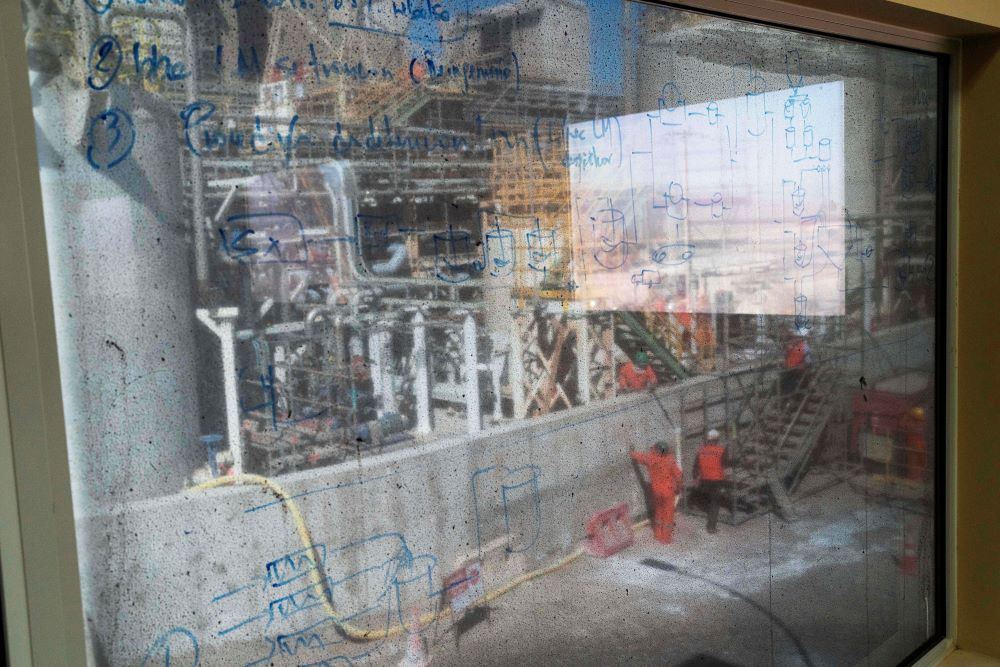
Notes are written on a window at the SQM Lithium company processing plant in Antofagasta, Chile, on April 19, 2023. (AP/Rodrigo Abd)
Here in the SQM mine, that means pumping at least 1,280 liters of salted groundwater a second — somewhere between 6 to 8 bathtubs — according to the mine's numbers. The tubes converge at rows of blue, green and yellow pools, where lithium-concentrated water is passed pool to pool.
The harsh desert sun evaporates the water, and strong winds often blow it out of the ecosystem, carried as far as Brazil, one mine official said. Because of the evaporation process and harsh winds, hardly any water can be reinjected into the soil. It leaves behind salt and lithium, to be processed and used by some of the world's biggest companies like Tesla.
Meanwhile, surrounding communities have watched their lands shrivel.
Farmers living near the mines complain of smaller crop yields.
Flamingos, feeding on microorganisms within the brine, have slowly been killed off by mining, a 2022 study showed. Their eggs were once a crucial part of the local diet, and the birds continue to be a big part of Indigenous celebrations.
Wells and lagoons next to the mines brimming with intense blue fresh water dried up. The grass livestock would once eat has vanished, he said.
In 2013, an environmental inspection found that a third of the carob trees — a plant known to survive in harsh environments — near the SQM mine had died. Many more trees were withering.
In 2022, SQM was ordered to pay $51.7 million to correct the damages caused by six infractions, including transparency concerns and contamination of fresh water wells.
"With the information we have available, we can say there has been no fundamental change in the surroundings (of the mines)," Barrera said.
He attributed court rulings and criticisms to "disinformation," and cast blame on state-run copper mines, also heavy water users. The mine's director later said that the water the lithium mines pump is slowly refilled by rain and fresh water in the mountains, a water source for local communities.
An Albemarle spokesperson insisted that the brine water they pump "is not water" because it is not drinkable.
Nearly a dozen scientists that spoke to The Associated Press said it is almost inconceivable that the heavy water use would have no environmental impact.
___
Lithium mining has also sparked an economic boom in parts of Chile.
Since the beginning of the Native Atacama people, generations of Ramon Torres' family guided their pack of goats along the rolling hills of Peine, a town sitting at the mouth of Chile's salt flats.

Dust is kicked up from the road as the de Callata family drives to the site where they raise livestock in Tusaquillas, Jujuy Province, Argentina, on April 23, 2023. (AP/Rodrigo Abd)
When companies started extracting lithium in the early 1980s, Ramon Torres was among the people to raise his hand. He worked the tinted pools, going from subsisting like his parents and grandparents to saving.
Today, he sits on the porch of his small brick house scrolling through his smartphone, both purchased with the money he earned from the mine. Cherry-red trucks loaded with miners rumble past his home on their way to a long day of work as the sun rises.
"There is development, but there's also the water issue. And they contradict each other," he said. "Because everyone needs money, everyone also needs the basics, like health care and education."
That same tension has divided mining towns like his in both Chile and Argentina: The economic benefits of lithium are undeniable. Mining makes up a whopping 62% of Chile's exports, a crucial backbone to the country's economy.
The money that the mines have brought has rippled across Peine. Torres now works building homes for and rents to mine workers that have flooded the region.

Elizabeth Mamani, 30, watches her son, Alexis, 10, paint the walls of their new house in Huancar, Jujuy Province, Argentina, on April 25, 2023. The Andean town is prospering because of the work available in nearby lithium mines. (AP/Rodrigo Abd)
Companies advertise investment projects in nearby towns, touting mobile dental clinics and soccer fields, in many ways filling the endemic absence of the Chilean government.
While brush and other greenery in the surrounding lands withered long ago, fresh water still arrives in Peine through artificial channels and water centers built by the companies, flowing from fresh water wells in nearby peaks.
Communities higher in the mountains say they now feel the effects, too, but without the perks from the companies.
Meanwhile, legal clashes with the mining companies have sowed tensions in Indigenous communities. Long-held traditions like ranching and shared community work have faded. Younger Atacameño generations leave their towns, often favoring work in the mining sector, leaving Indigenous communities with smaller populations.
A 2020 U.N. report said that mining has consumed 65% of water around the Atacama Salt Flat, "causing groundwater depletion, soil contamination and other forms of environmental degradation, forcing local communities to abandon ancestral settlements."
Researchers say that the worst effects of current pumping may only be felt years down the line.
"When the mines leave, what's going to happen to us?" Torres said. "Mining is all we have left."
Advertisement
As lithium mining has gained a greater global spotlight, the fate of water in the region has increasingly fallen out of the hands of those communities.
In April 2023, progressive Chilean President Gabriel Boric announced a plan aimed at offsetting the environmental impacts of the lithium sector by boosting government control of the lithium mines.
Government officials told the AP a new plan would allow them to better regulate water use and distribute wealth beyond "just a small few." But plans spurred outrage among Indigenous communities who said they were once again sidelined by government negotiations with the mines.
The move also had an adverse effect of pushing mining companies to invest in neighboring Argentina, where lithium mining's explosion has just begun.
Doors for the mining companies have also been left wide open under the country's new right-wing "anarcho-capitalist" leader Javier Milei, who was elected in November, under a promise to fix his country's spiraling economy.
He has announced a broad deregulation sweep, slashing costs for mining companies in an effort to lure investors amid deepening economic crisis. Milei's rise to power will likely further hamstring efforts by Indigenous communities to beat back mining companies.
While nearby Bolivia sits on more lithium than either country, its stores have largely remained untapped.
Meanwhile, the region has also increasingly become part of a larger tug of war between global powers like the U.S. and China as both countries seek to take advantage of the deep lithium stores. The Biden administration has also sought to offset growing Chinese influence in the region, with officials even claiming Chinese investment in the lithium sector is a democratic threat.

Irene Leonor Flores de Callata, 68, performs a brief ceremony to thank the Earth after inspecting her corn crop at her home in Tusaquillas, Jujuy Province, Argentina, on April 23, 2023. "If the [lithium] mines come, we’ll have money for a time. But then our grandchildren, our great-grandchildren — they're the ones who will suffer," she says. (AP/Rodrigo Abd)
Meanwhile, to Irene Leonor Flores de Callata and her small town of Tusaquillas, the mounting interest in their home represents another nightmare scenario.
She looks at the stretching salt flats, and the water that has breathed life into their barren land.
She looks at her small corral of livestock she has spent decades leading to through the desert.
And Flores de Callata looks at the adobe house she and her husband built from nothing, where her grandchildren now wrap their arms around her on the way home from school.
She wonders what will be left in 20 years.
"If the mines come, we'll have money for a time. But then our grandchildren, our great-grandchildren — they're the ones who will suffer," she said. "I want to do everything possible to defend these lands, so they still have these fields, so they still have their waters."





